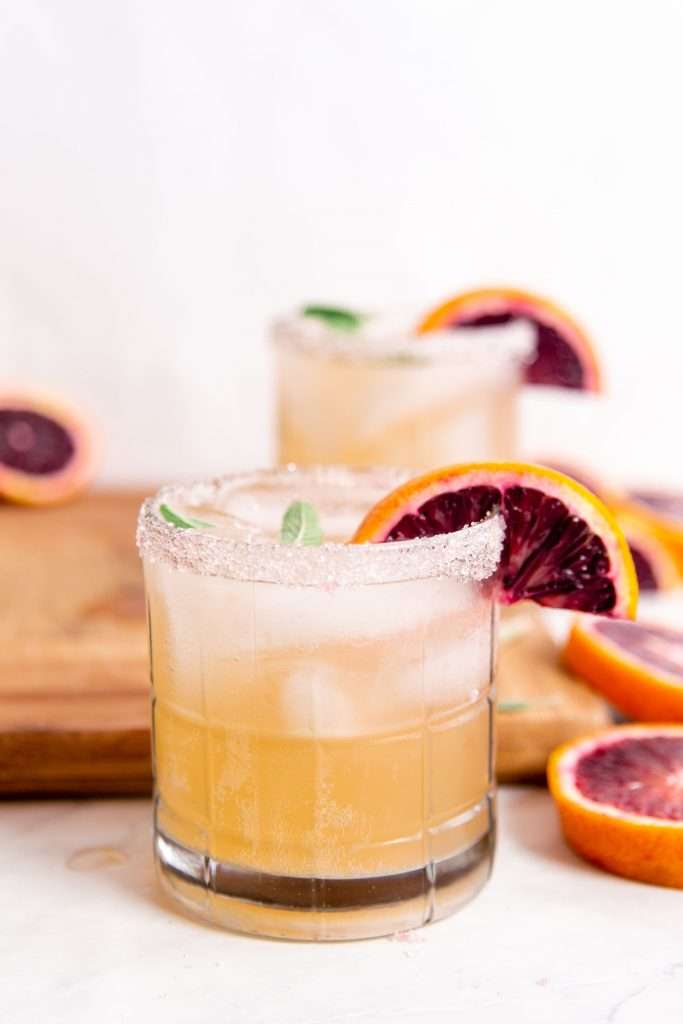Blood orange kombucha with sage is one of the best kombucha flavor combinations! This sage blood orange kombucha recipe is for a second fermentation flavoring and carbonation.

Blood Orange Kombucha Flavor
To flavor kombucha, you can use freshly squeezed juice or bottled juice. I prefer to use organic 100% juice that’s been pasteurized.
If you decide to use freshly squeezed juice, it’s best to heat it up to boiling and cool it before adding it to the bottle for secondary fermentation. Heating the juice helps avoid any contamination. You can also infuse any herbs you want to use into the juice while heating it.
You probably won’t be able to find blood orange juice bottled, so it’s best to use fresh squeezed. I can usually find fresh blood oranges at our produce market starting in January.

Kombucha Primary Fermentation
CLICK HERE for our Primary Kombucha Fermentation Recipe.
Kombucha is made in two steps, primary fermentation and then secondary fermentation.
During primary fermentation, you use a SCOBY to culture sweet tea. The microbes in the SCOBY make the tea more acidic and a little less sweet.
You can drink the fermented sweet tea directly after primary fermentation. Most people like to bottle and flavor kombucha, though.
Blood Orange Kombucha with Sage and Honey
You can bottle the fermented sweet tea from primary fermentation with juice and sometimes herbs for another round of fermentation. This is called secondary fermentation, which we do in this recipe.
Citrus lends the best flavors for kombucha secondary fermentation. I almost always opt for a citrus flavor or a blend of fruit flavors that includes some citrus.
Since the kombucha carbonates during secondary fermentation, you must use carbonation-safe bottles for this step. You can also recycle kombucha bottles from the store for flavoring and bottling.


Kombucha Second Fermentation Supplies & Safety
For a quality second fermentation, I recommend using a bale top bottle. This is the best way to achieve a good level of carbonation.
Before purchasing a bale top bottle, verify from the seller that they are pressure safe and intended for fermentation. Again, I want to mention that you can recycle kombucha bottles from the grocery store for the second fermentation. Since the bottles are designed for high carbonation, they’re safe to use.

Blood Orange Kombucha with Sage and Honey
Blood orange kombucha with sage is one of the best kombucha flavor combinations! It’s the perfect herbaceous, citrusy flavor combination for fizzy kombucha. This sage blood orange kombucha recipe is for a second fermentation flavoring and carbonation.
- Prep Time: 10 minutes
- Cook Time: 0 minutes
- Total Time: 10 minutes
- Yield: 1 Quart
- Category: Drinks
- Method: Fermentation
- Diet: Vegan
Ingredients
- fermented sweet tea from primary fermentation
- fresh sage leaves
- blood orange juice, fresh squeezed
- raw honey
Instructions
- How much juice you need depends on how many bottles you would like to make. For a 1-liter bottle, you will need about 4 oranges, 5 sage leaves and two teaspoons of honey.
- Heat the blood orange juice, honey and the sage leaves in a small pot until it simmers. Strain out the sage leaves, and let the juice cool.
- Fill a 1-liter swing top bottle about halfway with fermented sweet tea from primary fermentation.
- Top off the bottle with blood orange juice so that there is about an inch of headspace left in the bottle.
- Secure the bottle lid and gently invert it a couple times to mix.
- Allow it to ferment at room temperature (70-80 degrees F) for 5 Days.
- Carefully open the lid to see if it is carbonated to your liking. If it is refrigerate, if not continue to ferment for a few more days, then carefully check the carbonation again.
- Keep refrigerated





1 comment
This looks like a beautiful kombucha! We make a blood orange kombucha in our little microbrewery in Melbourne (https://monceau.com.au) and swear by the natural carbonation of the second fermentation too!